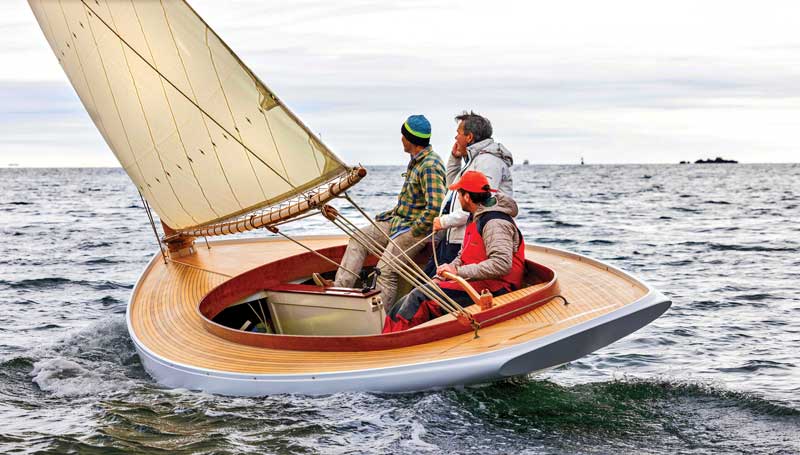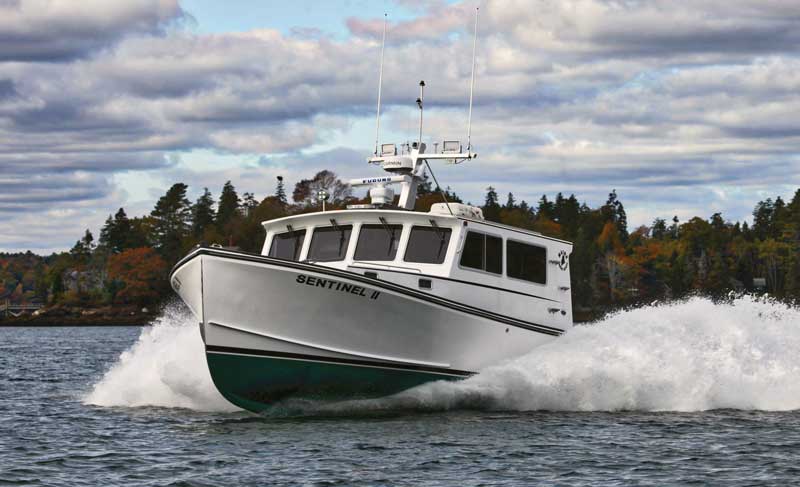 It took a team effort to recreate a vintage Gil Smith-like cat boat named Whirlwind II at Artisan Boatworks. Photo by Alison Langley
It took a team effort to recreate a vintage Gil Smith-like cat boat named Whirlwind II at Artisan Boatworks. Photo by Alison Langley
Whirlwind II project
After more than five years of research and construction, a modern version of a vintage Gil Smith-designed wooden catboat was launched this fall by Artisan Boatworks for a quick test sail before going back into the shop for more fine-tuning.
Yarrow Thorne, who commissioned the boat and conceived of the project, said he was thrilled with the performance of Whirlwind II. “No one knew if this thing would work. We just needed to see it in action,” he said, noting that the design started with an old half model. “We put it through its paces for two hours and learned a lot…Now we have a really good example of what Gil was thinking when he decided to design and build a very fast boat for himself.”
Smith, who produced around 400 boats between 1876 and 1939 in his yard in Patchogue, Long Island, was known for his speedy, elegant, catboats. Whirlwind II’s design is based on lines taken from a half model Smith carved for a boat named Mariam after his wife, who worked with him and sewed the sails for his boats, as well as line drawings of Mariam that the team found in old issues of Rudder Magazine.
The team behind the Whirlwind II project includes designer Ezra Smith; naval architect Matthew Smith (no relation to each other or to Gil Smith); builder Alec Brainerd and his crew at Artisan; sailmaker Eben Wilson, the son of long-time sailmaker Nat Wilson in East Boothbay; Moore Brothers Co. of Bristol, Rhode Island, which built the carbon mast and spars; multimedia storyteller Pearl Marvell; and photographer Alison Langley.
Although Whirlwind II’s white hull is a mixture of wood-epoxy construction and her spars are carbon-fiber, painted to look wooden, the overall impression is of a vintage yacht. The catboat is 26 feet, 2 inches overall, with a waterline length 19 feet, 9 inches, a beam is 8 feet, 7 inches, a draft with board up of 1 foot, 9 inches, and 3 feet, 10 inches, with the board down. The displacement is 2,425 pounds and the sail area is 536 square feet.
The official launch is expected to happen this spring. You can read more about the project at whilwind2.com/build.
 The Patrol Vessel Sentinel II is a new state-of-the-art addition to the Maine Marine Patrol fleet. Photo courtesy Jon Johansen
The Patrol Vessel Sentinel II is a new state-of-the-art addition to the Maine Marine Patrol fleet. Photo courtesy Jon Johansen
New patrol boat
The Maine Marine Patrol has added a new patrol vessel to its fleet. The P/V Sentinel II, a 42-foot long, 15-foot wide Calvin Beal-designed hull, was launched in South Bristol and will be stationed in Jonesport. The vessel’s hull and top were provided by SW Boatworks in Lamoine, the engine was provided by Billings Diesel and Marine in Stonington, and the vessel was built and finished by Farrin’s Boat Shop in Walpole, according to a news release from the Department of Marine Resources.
This is the second 42-foot Calvin Beal vessel Marine Patrol has had built in recent years; both vessels replaced existing patrol boats. “We were fortunate to be able to contract with Farrin’s Boat Shop again to build the Sentinel II and are very happy with the finished product. Farrin’s produces an excellent Maine lobsterboat and was exceptionally accommodating during the build process,” said Marine Patrol Colonel Matt Talbot.
The P/V Sentinel II will replace the P/V Maine, a 25-year-old, 42-foot Wesmac. “This new vessel will serve as the cornerstone for our officers’ at-sea patrol work in eastern Maine for years to come. I can’t think of a better place on the coast for patrol to have a “Beals Island-style” patrol boat than Jonesport-Beals,” Talbot said.
Shipworm digestion explained
For thousands of years, shipworms chewed up wooden vessels and ravaged wharfs, leading to many a shipwrecked sailor. Their damage included structures and boats in Maine (see “Shipwrecks, Shipworms and the Fate of Forests in the Sea,” MBH&H Issue 183, July/Aug 2023). But exactly how they have been able to wreak such havoc has remained a mystery, until now.
A new study has revealed how shipworms, officially known as teredo, are able to digest lignin—the toughest material in timber. Researchers found never-before-seen symbiotic microbes hidden away inside a tiny sub organ in shipworms’ guts called the typhlosole. They further concluded that those microbes secrete enzymes that are able to break open the wood at the molecular level and allow digestion.
The team behind the study was led by Barry Goodell, professor emeritus of the University of Maine’s School of Forest Resources and recently retired professor of microbiology with the University of Massachusetts Amherst. “We’ve been trying to crack this mystery for years,” he said, “and we finally discovered the shipworm’s hidden bacterial symbiont secret.”
Findings from the study can support future research into greenhouse gas emissions, help enhance bioindustrial processes and inspire the development of natural products that bolster human health, according to the press release.
Drunkard Ledge is now marked
There is at long last a new buoy marking Drunkard Ledge, in West Penobscot Bay, near North Haven and the mouth of the Fox Island Thorofare.
The ledge, which is visible at high tide, but not low tide, was marked in past years by a spindle. But faced with almost yearly destruction of those spindles in winter storms, and because the Drunkard is shown on charts, both paper and electronic, the Coast Guard announced last year that it was abandoning the mark. Local mariners, including captains on the ferry serving North Haven, spent the past year convincing the Coast Guard that indeed many boats, including the ferry, often navigate close by the ledge. Instead of a bigger sturdier spindle, the coast guard placed a lighted buoy just to the SE of the Drunkard in late October. One ferry crew member described the move as, “welcoming.”
A note on North Haven’s Facebook page thanked a handful of former and current ferry captains and ferry service personnel, U.S. Rep Chellie Pingree, and all the mariners who wrote letters and filled out online forms.
 Historic New England honors Maine’s State Historian Earle G. Shettleworth Jr. with its Preservation Leadership Award. Photo courtesy Historic New England
Historic New England honors Maine’s State Historian Earle G. Shettleworth Jr. with its Preservation Leadership Award. Photo courtesy Historic New England
Historian makes history
Earle G. Shettleworth Jr. has been honored by Historic New England with its second Preservation Leadership Award in recognition of his lifelong dedication to promoting and protecting Maine’s history and architecture. His leadership stands as an inspiration not only to Mainers, but to all New Englanders who share his passion for and commitment to preserving the built environment, cultural landscapes, and the region’s history, Historic New England announced in a press release.
A native of Portland, Maine, Shettleworth attended Deering High School, Colby College, and Boston University. He has received honorary degrees from Bowdoin College, Colby College, and the Maine College of Art. His storied career includes a 40-year tenure as director of the Maine Historic Preservation Commission, from which he retired in 2015, and six terms (and counting) as Maine’s State Historian.
Shettleworth is a regular, and valued, contributor to Maine Boats, Homes & Harbors magazine.
Bristol Marine acquires Huckins
Bristol Marine, which owns yards in Maine, Massachusetts, and Rhode Island, has added to its holdings with the purchase of the Jacksonville, Florida-based Huckins Yacht Corp.
Buddy and Cindy Purcell, who is the granddaughter of Huckins founder Frank Huckins, announced the news this fall in a letter sent to members of the boating industry.
“Bristol Marine founder and CEO Andy Tyska brings a wealth of experience to Huckins, with a degree in Naval Architecture from the University of Michigan and 27 years of experience operating boatyards,” the Purcells wrote.
“What impressed us most about Andy is his deep appreciation for the Huckins brand and our commitment to quality. We’re confident that his expertise will help Huckins continue to thrive while honoring our heritage.”
The Purcells noted that much of their existing team will remain in place including general manager Sara Gielow, and service manager PJ Rogers.
“I look forward to the next year or two, doing a lot of listening to current Huckins owners about the experience with the boat they have now, and what they see as the future of Huckins,” Tyska told the web news service Trade Only Today. And he said he dreamed about getting a new Huckins model in the water in the future, “without question.”
The CAT ferry gets another year
After facing a series of challenges over several years, The CAT ferry which travels between Bar Harbor, Maine, and Yarmouth, Nova Scotia, saw its usage increase roughly 30 percent over last year. And the Nova Scotian government, which subsidizes the service, announced this fall that it plans to continue providing operating funds for the ferry in 2025 and 2026, according to a story in the Bangor Daily News. Operated by the Canadian firm Bay Ferries Ltd., the seasonal ferry service saw 2024 totals of nearly 50,000 passengers and 20,000 vehicles, according to Bay Ferries. That’s roughly 12,000 more passengers and 5,000 more vehicles than it carried last year, and 14,000 more passengers and 5,000 more vehicles than in 2022.
Sea squirts in bloom
Warming ocean temperatures are boosting the populations of sea squirts in Maine’s coastal waters, causing problems for fishermen and recreational boaters, according to a recent story in the Bangor Daily News.
The small tunicates, several species of which are invasive, are attaching themselves in large numbers to lobster traps and aquaculture equipment, creating hassles for harvesters. Boaters who leave their moorings vacant for too long may also find them encrusted with the gelatinous creatures, which squirt when pressed, hence the name.
They can grow so heavily on mussel ropes and oyster cages that they threaten to suffocate the creatures that sea farmers are trying to cultivate, according to marine scientist Brian Beal.
The creatures’ increasing presence in the Gulf of Maine is one of several shifts in species being found off Maine’s coast that scientists contend are fueled by climate change and warming waters, according to the BDN. Other invasive species on the rise include black sea bass and green crabs, while cod and herring are in decline.
According to a webpage created by the Department of Marine Resources, tactics for managing sea squirts include letting the lines they are on dry out, or spraying them with white vinegar. Scraping them off and dumping them in the sea is not ideal as they might not die and it could result in a greater population, according to DMR.
Unmanned exploration
Mariners offshore might have noticed unusual unmanned sailing vessels last summer in the Gulf of Maine. Two Saildrone Voyager uncrewed surface craft equipped with state-of-the-art Norbit multibeam echo sounders were gathering data at depths up to 300 meters around the Jordan and Georges basins. The data has revealed a complex underwater landscape, according to NOAA researchers.
“NOAA and partners are very interested in better understanding habitats in the region that may support fish production. These high-resolution seafloor maps will inform future surveying and modeling efforts, as well as aid in the New England Fishery Management Council’s fishery management decisions,” said NOAA fisheries researcher Heather Coleman in a press release.
The high-resolution maps will guide visual surveys of coral and sponge habitats using remotely operated vehicles for multiple NOAA cruises in 2024 and 2025. The data will also inform new species distribution models in the Gulf of Maine, which until now was not possible because of the lack of high-resolution seafloor information, Coleman said.
The drones, which are about 33 feet long, travel at 2 to 4 knots and are designed to be highly visible.
Sea farm goes electric
Thanks to a grant from the U.S. Department of Energy and matching funds, Maine Ocean Farms is going electric. The Freeport-based oyster farm is acquiring a custom-built electric workboat and installing Aqua superPower’s marine, fast charging stations.
Aqua superPower is leading the electrification project, in partnership with Maine Clean Communities. Fogg’s Boatworks in North Yarmouth, will design and build the workboat. Vita Power will design and manufacture the electric powertrain with suitable battery size and power output for the new fleet vessel. Aqua superPower will install two DC marine fast charging stations.
“Maine Ocean Farms strives to continuously innovate our operations, embracing new technologies that can drive positive environmental change while supporting local economic growth,” Willy Leathers, director of Farm Operations and founding partner of Maine Ocean Farms said. “This project will demonstrate these technologies in action, providing data and real-time experience to other farmers and industry members.”
New leader at MITA
The Maine Island Trail Association has named Ben Dougherty as the organization’s new executive director. Dougherty succeeds Doug Welch, who served in the role for 17 years.
Dougherty, who was born and raised on the coast of Maine, most recently served as CEO and head of school for The Island School on Eleuthera in The Bahamas. He brings more than 20 years of experience in outdoor and experiential education that began with guiding multi-day kayak trips in Maine for the Hurricane Island Outward Bound School from 2002 to 2004.
Dougherty graduated from the University of Montana with a BS in forest ecology and wildlife biology, and holds a masters of education from the University of Pennsylvania. He was the head of upper school at The Derryfield School in Manchester, New Hampshire, from 2014 to 2020.
Founded in 1988, MITA administers the Maine Island Trail.
Energy from the sea
A recent auction by the federal Bureau of Ocean Energy Management for eight offshore wind leases in the Gulf of Maine resulted in the sale of four lease areas to two buyers for wind farms, generating over $21.9 million in winning bids.
BOEM said the two provisional winners are Avangrid Renewables and Invenergy NE Offshore Wind. Together, the leased areas have the potential to power more than 2.3 million homes with clean energy, according to BOEM.
The leases provide the right to submit a project plan for BOEM’s review. And the federal agency will then analyze the specific impacts before making decisions on whether to approve a proposed construction and operations plan.
Meanwhile, the Federal Energy Regulatory Commission has issued a preliminary permit for a proposed tidal power project in Pembroke, despite widespread opposition to the proposal, according to a story in the Quoddy Tides.
The permit, for a term of four years, allows Pembroke Tidal Power Project to gather data and information to prepare a license application. According to the Tides, the project would include a 9.8-by-1,640-foot concrete tidal diversion dam; a 118-by-141-foot concrete powerhouse caisson housing four turbine generators, each with a generating capacity of 5.3 megawatts; a boat lift; two rock embankments; and a 2.5-mile-long, 35-kilovolt transmission line connecting to the regional grid. Annual generation is estimated at 87,000 megawatt hours.
✮






